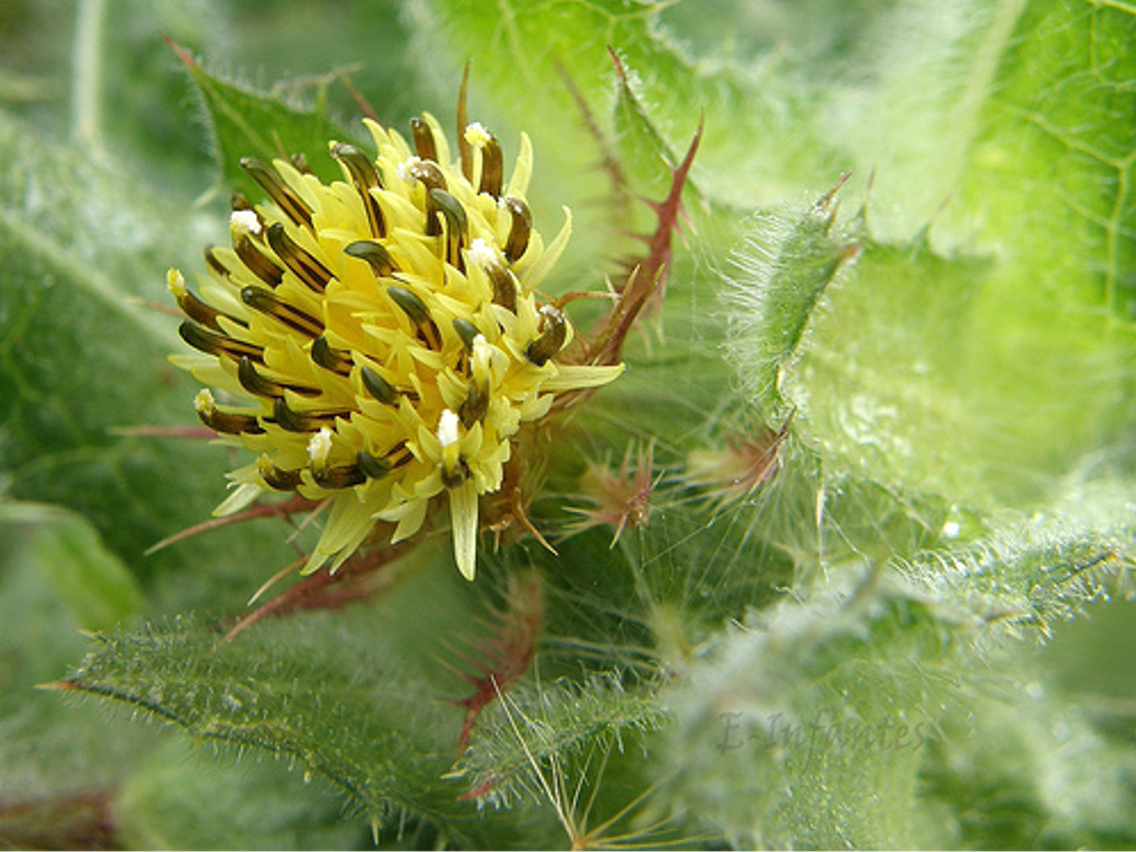Blessed Thistle - Cnicus benedictus

Common Names: Blessed Thistle, Holy Thistle, St. Benedict's Thistle, Bitter Thistle, Spotted Thistle, Cnicus benedictus, Centaurea benedicta, Carduus benedictus, Benedictine Thistle, Chubet, Krasovlasek, Zajeci ousko, global, Latin, English, origin
Latin Name: Cnicus benedictus
Origin: Africa, Asia, Europe, North America
Short Introduction
To successfully cultivate Blessed Thistle, it is important to keep a few basics in mind. The plant prefers slightly moist soil in a sunny and sheltered location, but it also requires good-quality soil. Blessed Thistle thrives best in calcareous, humus-rich soils. The seeds are best sown directly on the surface outdoors in early spring (some sources recommend late April). Germination usually occurs within 10 days.
Detailed Description
A classic herb known for supporting digestion, with scientifically demonstrated antiviral properties.
Botanical Information
Blessed Thistle, Cnicus benedictus, is an annual herb that can reach up to 60 cm in height. Its leathery, hairy leaves are elongated—up to 30 cm long and 8 cm wide—lined with short spines along the edges. The lower leaves are stalked and deeply lobed, while the upper leaves are more sessile (stem-clasping) and lobed. The upright stem is grooved, branched, reddish to slightly orange, strongly hairy, and oval to pentagonal in shape. Its bright yellow tubular flowers form dense clusters, each about 3–4 cm in diameter. The marginal florets are usually small and sterile. Blessed Thistle blooms in June and July.
Origin and Distribution
Blessed Thistle is native to the Mediterranean. It spread from the Mediterranean region through Portugal and northern France all the way to Central Asia, including present-day eastern Iran, Syria, the Caucasus, and across much of the Middle East. Today, it can also be found in many other parts of the world, including North America, where it sometimes has a reputation as a nuisance weed. In many regions, however, it is deliberately cultivated, and in some areas (such as Central Europe, America, and southern Africa) it has naturalized.
Usage / Dosage
The primary therapeutic use of Blessed Thistle is in treating ailments related to the digestive system. It supports digestion, tones the digestive tract, and, as a classic bitter herb (amarum), helps the body produce digestive juices and bile. It is recommended for weak stomach, poor appetite, bloating, inflammation of the digestive mucosa, or post-operative recovery. It is also a common remedy in traditional folk medicine for gallbladder and liver issues, gout, and rheumatism. Additionally, it acts as a diuretic and increases the excretion of uric acid, making it useful for rheumatism and gout. Blessed Thistle is a classic ingredient in herbal blends for liqueur production (notably in the famous Benedictine liqueur). It is also an important component of the legendary Swedish bitters.
Blessed Thistle’s notable therapeutic value also lies in the potential of its active constituents to act as antibacterial and anticancer agents. It is considered one of the most effective plant-based remedies to inhibit uncontrolled cell division, thus serving as a traditional cytostatic (anti-tumor) herb. Externally, Blessed Thistle helps treat rheumatism and gout, supports wound healing, soothes skin inflammations, varicose ulcers, eczema, and is used successfully for psoriasis. It acts as a moderately powerful disinfectant. Its compounds have demonstrated antiviral properties—there are even indications that Blessed Thistle may have destructive effects on the HIV virus—and it is recommended for treating shingles.
In Ontario, Canada, a 0.2% extract of the active substance cnicin from Blessed Thistle has a long-standing tradition for supporting breast milk production in new mothers as a galactagogue. Many communities and organizations specifically recommend this raw extract to aid breastfeeding.
Blessed Thistle tea is also incorporated into herbal blends for supporting nervous system function (such as calming teas, and blends that aid learning and cognition). For therapeutic purposes, the aerial parts of the herb are collected just before flowering (June to July). It is best dried in the shade or in a dryer at a constant temperature around 40°C (104°F).
Active Compounds
Blessed Thistle contains arctigenin, nortracheloside, and in very small amounts, wikstromol—all lignan compounds. Clinical studies indicate these substances suppress virus replication (showing a virostatic effect) and reduce inflammation caused by viruses.
The plant also contains a high percentage of tannins (about 8% of its dry mass), which play an important role in wound healing. Essential oils (such as citral and cymene), resins, flavonoids, and mucilage are also present.
Mineral salts—including magnesium and potassium—and B vitamins are found as well. Its characteristic bitter taste comes from bitter principles (chemically sesquiterpene lactones) such as cnicin and salonitenolide.
Traditional Dosage
For internal use, it is recommended to steep 1 teaspoon (or 10 g) of dried herb in 200 ml of water for 5–10 minutes, and drink 2–3 cups daily on an empty stomach. Care should be taken to avoid potential issues detailed below.
Warning: Proper dosage is important with Blessed Thistle. Exceeding the recommended amount may cause stomach upset or even vomiting. If these symptoms occur, it is advisable to discontinue use for a time due to the risk of kidney irritation. It is contraindicated in cases of serious kidney disease.
